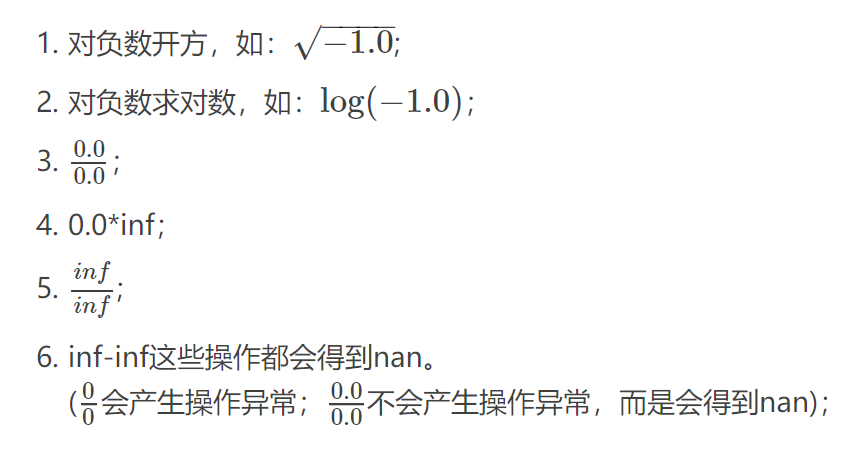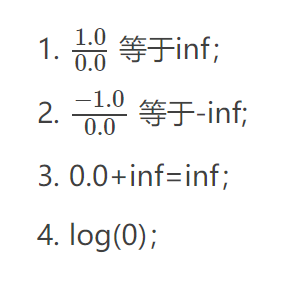前言
在数据处理输入输出时,极有可能遇到数据读入空值(极大、极小)、运算中分母为0或0.0,对0取对数等操作,这将产生nan或inf的产生。这篇博文旨在分析C/C++产生nan和inf的操作及判断是否有nan或inf产生。
NAN的产生原因
nan: not a number,表示“无效数字”。
注意:nan是无序的(unordered),无法对其进行逻辑运算。它不大于、小于或等于任何数(包括它自己),将<,>,<=,和>=作用于nan产生一个exception。得到nan时就查看是否有非法操作,如果表达式中含有nan,那么表达式的结果为nan。
INF的产生原因
INF:infinite,表示“无穷大”。
超出浮点数的表示范围(溢出,即阶码部分超过其能表示的最大值)。
注意:+inf大于任何数(除了它自己和nan),-inf小于任何数(除了它自己和nan),得到inf时就查看是否有溢出或者除以0。inf在C语言表达式中就表示数学里无限的概念,如1.0/inf等于0.0,并可以与其他浮点数进行比较的(可以参与<=、>+、==、!=等运算)。
nan和inf的判断
下面几个宏即包含在math.h头文件,可用于判断一个表达式的结果是否为inf、nan或其他。使用时包括include
include<math.h>int isfinite(x);int isnormal(x);int isnan(x);int isinf(x);
打开math.h可以看到定义:
#define isnormal(x) \( sizeof(x) == sizeof(float) ? __inline_isnormalf((float)(x)) \: sizeof(x) == sizeof(double) ? __inline_isnormald((double)(x)) \: __inline_isnormall((long double)(x)))#define isfinite(x) \( sizeof(x) == sizeof(float) ? __inline_isfinitef((float)(x)) \: sizeof(x) == sizeof(double) ? __inline_isfinited((double)(x)) \: __inline_isfinitel((long double)(x)))#define isinf(x) \( sizeof(x) == sizeof(float) ? __inline_isinff((float)(x)) \: sizeof(x) == sizeof(double) ? __inline_isinfd((double)(x)) \: __inline_isinfl((long double)(x)))#define isnan(x) \( sizeof(x) == sizeof(float) ? __inline_isnanf((float)(x)) \: sizeof(x) == sizeof(double) ? __inline_isnand((double)(x)) \: __inline_isnanl((long double)(x)))
使用方法,及结果:
int isfinite(x) ,判断x是否有限,是返回1,其它返回0;int isnormal(x),判断x是否为一个数(非inf或nan),是返回1,其它返回0;int isnan(x),当x时nan返回1,其它返回0;int isinf(x) ,当x是正无穷是返回1,当x是负无穷时返回-1,其它返回0。有些编译器不区分。
测试
产生nan或inf的操作,使用库函数(宏)判断
#include <iostream>#include <math.h>using namespace std;int main(int argc, char *argv[]){//nancout << "nan: " << sqrt(-1) << endl;cout << "nan: " << log(-1.0) << endl;cout << "nan: " << 0.0 / 0.0 << endl;cout << "nan: " << 0.0 * sqrt(-1) << endl;cout << "nan: " << sqrt(-1) / sqrt(-1) << endl;cout << "nan: " << sqrt(-1) - sqrt(-1) << endl;//infcout << "inf: " << 1 / 0.0 << endl;cout << "-inf: " << -1 / 0.0 << endl;cout << "inf: " << 0.0 + 1 / 0.0 << endl;cout << "-inf: " << log(0) << endl;cout << "isfinite: 0" << isfinite(0.0 / 0.0) << endl;cout << "isfinite: 0" << isfinite(1 / 0.0) << endl;cout << "isfinite: 1" << isfinite(1.1) << endl;cout << "isnormal: 0" << isnormal(0.0 / 0.0) << endl;cout << "isnormal: 0" << isnormal(1 / 0.0) << endl;cout << "isnormal: 1" << isnormal(1.1) << endl;cout << "isnan: 1" << isnan(0.0 / 0.0) << endl;cout << "isnan: 0" << isnan(1 / 0.0) << endl;cout << "isnan: 0" << isnan(1.1) << endl;cout << "isinf: 0" << isinf(0.0 / 0.0) << endl;cout << "isinf: 1" << isinf(1 / 0.0) << endl;cout << "isinf: 0" << isinf(1.1) << endl;return 0;}
参考
http://www.gnu.org/software/libc/manual/html_node/Infinity-and-NaN.html
http://www.cnblogs.com/dosrun/p/3908617.html

